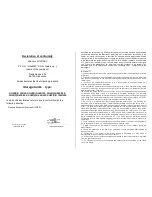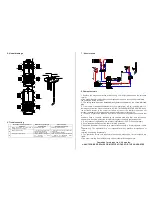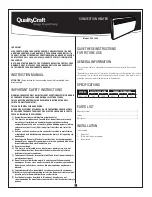
Declaration of conformity
Directive 97/23/EEC
P.P.U.H. “GALMET” S.D.R. Galara sp. j.
(name of the company)
Raciborska str. 36
48-100 Glubczyce
hereby declares that the following products:
Storage tanks , type:
SGW(S)K 300/80, SGW(S)K 380/120, SGW(S)K 500/160,
SGW(S)K 600/200, SGW(S)K 800/200, SGW(S)K 1000/200
to which this declaration refers to are in conformity with the
following directive:
-
Pressure Equipment Directive 97/23/EEC
Głubczyce, 01.05.2004 .
(Place and date)
………..……………………………….
(Authorised signature)
Assemble the safety valve e.g. Zb9 by Orkli (Spain) on the cold water feed pipe according
to the arrow indicating the direction of water flow that is located on valve body. In the
heater, the safety valve enables to decrease the pressure without water outflow outside
through its flow to the feeding system. It opens the outflow in case of differential pressure
in the heater and the system amounting to 0.07+0.03/-0.02 MPa; therefore, in the distance
of 5 meters from the safety valve, the cold water feed pipe should endure temperature
+90°C (due to the possibility of hot water flow from the container to the system). The
discharge hole of the safety valve needs to be constantly open - connected with the
atmosphere.
4. Note !!!
1. Connect the external tank to the central heating system after the internal tank is filled in
with water.
2. The safety valve hast to be assembled directly before the heater on the cold water feed
pipe. Use only and solely valves adjusted to storage water heaters that also include a non-
return valve.
3. There can be no additional devices (e.g. a cut-off valve, a non-return valve etc.)
between the safety valve and the heater.
4. Do not use the heater without operational safety valve. Check operation of the safety
valve every 14 days by turning the hood right or left so that there is a discharge from the
side external outlet. Then turn
the hood in the opposite direction until it clicks in the previous position and press it down
to the valve body. Note - there is a possibility of hot water discharge. The company
disclaims any responsibility for malfunctioning of the safety valve resulting from incorrect
valve fitting. The maximum pressure of fully open safety valve cannot exceed 0.67 MPa.
for C/H containers however for buffer tank in system closed 0.35 MPa..
5. Do not try to prevent water from dripping from the safety valve - do not plug the
discharge hole of the safety valve. If water constantly leaks out from the safety valve, it
means that the pressure in the water supply system is too high or the safety valve is out of
order. The valve outlet should be directed downwards. It is recommenced that a funnel
that discharges water is placed under the valve. It is also possible to place a hose on the
outlet that discharges water leakage arising when opening the safety valve. The hose
should be resistant to temperature up to +80°C, have a 9 mm internal diameter and 1.2 m
maximum length, led to the outlet with a downward slope (min. 3%) in the environment in
which temperature does not fall below 0°C. The hose required protection against
decreasing opening area (folding, plugging) and its outlet should be visible (to check valve
operation).
6. There cannot by any devices that cause the so-called water hammer in the system in
which the heater is fitted, e.g. a ball valve used as a flushing valve.
7. Switch the heater off immediately if smoke comes out of any battery (notify the
manufacturer).
8. Check the protection of the heater by measuring neutral grounding effectiveness at
least once a year.
9. Connection of the heater to the mains without a grounding pin may result in
electrocution in case of failure of electric equipment.
10. At least once a year, replace the magnesium anode in enameled containers (excluded
from the guarantee service).
11. To extend service life of the container and ensure effective operation of the safety
valve, use filters






















